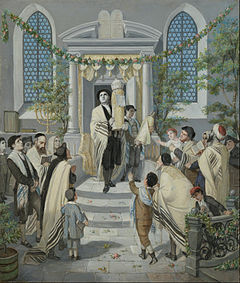Shavuot
Shavuot
| Shavuоt | |
|---|---|
 Shavuot by Moritz Daniel Oppenheim | |
The word Shavuot means "weeks",
and it marks the conclusion of the Counting of the Omer. Its date is directly
linked to that of Passover; the Torah mandates the seven-week Counting of the
Omer, beginning on the second day of Passover, to be immediately followed by
Shavuot. This counting of days and weeks is understood to express anticipation
and desire for the giving of the Torah. On Passover, the people of Israel were
freed from their enslavement to Pharaoh; on Shavuot, they were given the Torah
and became a nation committed to serving God. One of the biblically ordained Three Pilgrimage Festivals, Shavuot is
traditionally celebrated in the Land of
Israel for one day and for two days in the Diaspora.
While there is more awareness of the festival in Israel among secular Jews,
generally Shavuot is widely ignored by non-practising Jews. Significance Agricultural (wheat
harvest) Shavuot is not explicitly named as the day on which
the Torah was revealed by God to the Israelite nation at Mount Sinai in the
Bible, although this is commonly considered to be its main significance. What is textually connected in the Bible to the
Feast of Shavuot is the season of the grain harvest, specifically of the wheat,
in the Land of Israel. In ancient times, the grain
harvest lasted seven weeks and was a season of gladness (Jer. 5:24, Deut. 16:9–11, Isa. 9:2). It began with the
harvesting of the barley during Passover and ended with the harvesting of the
wheat at Shavuot. Shavuot was thus the concluding festival of the grain
harvest, just as the eighth day of Sukkot (Tabernacles)
was the concluding festival of the fruit harvest. During the existence of
the Temple in Jerusalem, an offering of
two loaves of bread from the wheat harvest was made on Shavuot. The one but last Qumran Scroll to
be published has been discovered to contain two festival dates observed by the
Qumran sect as part of their formally perfect 364-day calendar, and dedicated
to "New Wine" and "New Oil", neither of which are mentioned
in the Hebrew Bible, but were known from another
Qumran manuscript, the Temple Scroll.
These festivals "constituted an extension of the festival of Shavuot...,
which celebrates the New Wheat". All three festivals are calculated
starting from the first Sabbath following Passover, by repeatedly adding
exactly 50 days each time: first came New Wheat (Shavuot), then New Wine, and
then New Oil. Scriptural Names in the Torah In the Bible, Shavuot is called the "Festival
of Weeks" (Hebrew: חג השבועות, Chag HaShavuot, Exodus 34:22, Deuteronomy 16:10); "Festival of
Reaping" (חג
הקציר, Chag HaKatzir, Exodus 23:16),[12] and
"Day of the First Fruits" (יום הבכורים, Yom HaBikkurim, Numbers 28:26). Shavuot, the plural of a
word meaning "week" or "seven," alludes to the fact that
this festival happens exactly seven weeks (i.e. "a week of weeks")
after Passover.[
In the Talmud The Talmud refers
to Shavuot as ʻAṣeret (Hebrew: עצרת,"refraining"
or "holding back", referring
to the prohibition against work on this holiday and
to the conclusion of the holiday and season of Passover. Since
Shavuot occurs 50 days after Passover, Hellenistic Jews gave it the name
"Pentecost" (fiftieth day"). | |||||||
|---|---|---|---|---|---|---|---|


Comments
Post a Comment